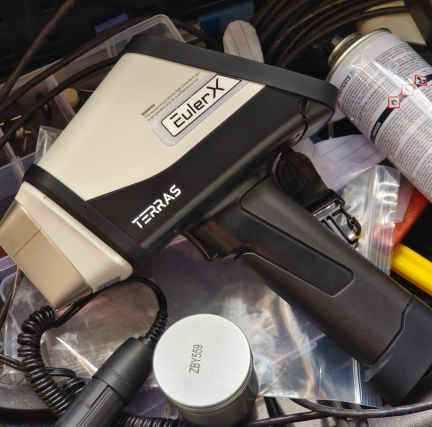
Alloy
A high-tech enterprise focusing on the development and application of X-ray technology products, committed to becoming a leading supplier of X-ray industrial testing solutions.
Why is There Such a Wide Range in XRF Machine Price? Detector and Software
If you've started shopping for an X-Ray Fluorescence (XRF) analyzer, you've likely encountered a dizzying array of prices.
It’s a natural question to ask: "Why the massive difference? They all basically do the same thing, right?"
While the core principle of XRF is consistent across devices, the execution is where the devil—and the cost—resides. Think of it like buying a car. Both a compact car and a luxury SUV will get you from point A to point B, but the performance, comfort, safety, and longevity are worlds apart.
Two of the most critical factors driving this price disparity are the detector and the software. Let's break down how these components turn a basic elemental analyzer into a powerful, application-specific scientific instrument.
The Heart of the Machine: Understanding Detector Technology
The detector is the core component that captures and measures the X-rays emitted by your sample. The type of detector used is arguably the single biggest factor in an XRF's performance and price.

1. Silicon Drift Detector (SDD) - The Modern Powerhouse
What it is: SDD is the current gold standard in handheld XRF, especially for demanding applications.
Performance: SDDs offer incredibly high resolution and can handle very high count rates. This means they can identify and measure elements with very close peak energies (like separating lead from arsenic) and do it very quickly.
Cost: High. The advanced manufacturing and materials required make SDDs significantly more expensive.
Best for: Applications requiring speed, precision, and the analysis of light elements (Magnesium, Aluminum, Silicon, Phosphorus, Sulfur). This includes alloy grade identification, geochemistry for mining, and environmental analysis for contaminants.
2. Silicon Pin Diode (PIN) Detector - The Cost-Effective Workhorse
What it is: An older, but still effective, detector technology.
Performance: PIN detectors have lower resolution and slower count rates compared to SDDs. This can lead to longer testing times and potential challenges in accurately distinguishing between elements with overlapping spectral peaks.
Cost: Much lower. This is the primary reason they are used in budget-friendly analyzers.
Best for: Simpler, more generalized tasks where the highest precision isn't critical. Think of basic scrap metal sorting (separating stainless steel from aluminum) or lead-in-paint screening where the target element is clear and distinct.
The Bottom Line on Detectors: An SDD-equipped XRF is like a high-speed, high-resolution scientific camera. A PIN-detector model is more like a standard point-and-shoot. Both take pictures, but the quality, detail, and speed are not comparable. You pay for that performance.
The Brain of the Operation: The Role of Software & Calibrations
If the detector is the heart, the software is the brain. The hardware collects raw spectral data, but it's the software that turns that data into actionable, reliable results.
1. Spectral Processing and Peak Deconvolution
High-end XRF software uses sophisticated algorithms to deconvolute, or separate, overlapping spectral peaks. This is crucial for complex materials where the signals from different elements interfere with each other. Cheaper software uses simpler math, which can lead to less accurate results, especially in challenging samples.
2. Calibration Libraries and Flexibility
Pre-Loaded Calibrations: All XRF analyzers come with pre-set calibrations for common applications (e.g., "Stainless Steel" or "Brass"). However, the depth and accuracy of these libraries vary greatly.
User Calibration & Fundamental Parameters (FP): This is a key differentiator. Expensive analyzers often include powerful FP software that allows you to create your own custom calibrations for unique or proprietary materials. A budget analyzer locks you into its pre-set modes, which may not be optimized for your specific needs.
3. Data Management and Connectivity
Basic Software: Might simply display a result on the screen, requiring manual recording.
Advanced Software: Transforms the analyzer into a data hub. It can include features like:
GPS tagging for geographical mapping of results.
Camera integration to photograph samples.
Wireless data export to cloud platforms or LIMS (Laboratory Information Management Systems).
Customizable report generation.
You are not just paying for the analysis; you are paying for the efficiency and traceability of the entire workflow.
Bringing It All Together: A Tale of Two Scenarios
Scenario A: The Scrap Yard
A scrap metal yard needs to quickly sort stainless steel from aluminum and identify basic copper alloys. They don't need to measure light elements, and their profit margins are thin. A PIN-detector XRF with basic software for under $25,000 is a perfect, cost-effective tool that pays for itself quickly.
Scenario B: The Mining Exploration Company
A geologist needs to precisely measure trace levels of precious metals (like gold or silver) in complex ore bodies in the field. They need to separate tantalum from niobium and require GPS-correlated data for resource modeling. For this, they need the high resolution and speed of an SDD detector, coupled with advanced geological software and custom calibration capabilities.
The EulerX900S Portable XRF Spectrometer: Speed, Reliability, and Portability.
Instant Analysis: Perform non-destructive testing with lab-quality results anywhere.
Broad Element Range: Accurately analyze elements from Magnesium (Mg) to Uranium (U).
Durable & Connected: Built to last, featuring a user-friendly touchscreen, Wi-Fi, and USB.
Versatile Applications: Ideal for QA, scrap metal recycling, and environmental monitoring.

Terras EulerX900S Handheld Alloy Analyzer
Conclusion: It's About Value, Not Just Price
The wide range in XRF machine prices isn't arbitrary. It directly reflects the capabilities of the detector and the sophistication of the software.
When evaluating your options, move beyond the sticker price and ask:
What is my specific application? Do I need light element analysis and high speed (SDD), or will a slower, general-purpose tool (PIN) suffice?
How accurate do I need to be? Will simple peak identification work, or do I need advanced deconvolution for complex materials?
What will make my team most efficient? Do I need robust data management, or is a simple on-screen result enough?
Ultimately, the right XRF analyzer is the one that solves your specific problem with the required level of precision and efficiency. Investing in the right detector and software from the start will save you from costly inaccuracies and limitations down the road, ensuring your analyzer is a true asset, not just an expense.
About Terra Scientific
Terra Scientific is a high-tech manufacturer specializing in the development and application of X-ray technology products. We are committed to becoming a world-class provider of X-ray industrial inspection solutions. Terra Scientific currently offers a range of products to global customers, including handheld alloy analyzer, handheld precious metal analyzer, handheld mining analyzer, benchtop precious metal analyzers, in-line analyzer, and spectrometer modules, along with XRF analyzers. We continuously serve global clients in fields such as mechanical manufacturing, metal processing, aerospace, petrochemicals, mining and geology, food safety, environmental protection, and scientific research.
To learn more, please don't hesitate to contact us via email at sales@terra-scientific.com, or visit our website at http://www.terra-scientific.com
Join Us
Subscribe to our email list for updates & promotions.



